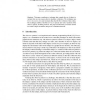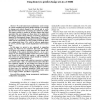17 search results - page 1 / 4 » Using History Invariants to Verify Observers |
ESOP
2007
Springer
13 years 11 months ago
2007
Springer
Abstract. This paper contributes a technique that expands the set of object invariants that one can reason about in modular verification. The technique uses history invariants, tw...
CONCUR
2010
Springer
13 years 5 months ago
2010
Springer
Optimistic concurrency algorithms provide good performance for parallel programs but they are extremely hard to reason about. Program logics such as concurrent separation logic and...
CSMR
2010
IEEE
12 years 11 months ago
2010
IEEE
To avoid unnecessary maintenance costs in large IT systems resulting from poorly planned changes, it is essential to manage and control changes to the system and to verify that all...
SIGSOFT
2004
ACM
14 years 5 months ago
2004
ACM
Dynamic detection of likely invariants is a program analysis that generalizes over observed values to hypothesize program properties. The reported program properties are a set of ...
PODC
2010
ACM
13 years 8 months ago
2010
ACM
We present a proof of safety and linearizability of a highlyconcurrent optimistic set algorithm. The key step in our proof is the Hindsight Lemma, which allows a thread to infer t...


